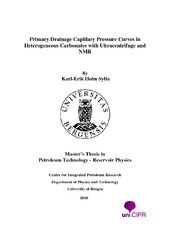| dc.description.abstract | Capillary pressure is one of the most fundamental rock-fluid characteristics in multi-phase flow, critically influencing both the initial reservoir fluid distribution and the dynamic processes of oil recovery. Thus, it is of great importance to obtain accurate capillary pressure-saturation relationships when examining reservoir rocks. This work investigates a new method for obtaining the primary drainage capillary pressure curve for heterogeneous carbonates in air-brine and oil-brine systems. The method uses an ultracentrifuge to create a distribution of fluids and capillary pressures in a rock core before a NMR method is used to measure the saturation profile within the rock. In order to widen the application of the method, a diffusion-weighted profile sequence is used for NMR measurements in oil-brine systems. The method is able to provide a primary drainage capillary pressure curve in 3 days, and is therefore considered as a rapid alternative to other methods. By comparing results obtained for a relatively homogeneous Berea sandstone with that of more heterogeneous carbonate samples, the effects of heterogeneity are evident. The complexity of the studied material is reflected in the resulting capillary pressure curves, illustrating how heterogeneities violate classical concepts and assumptions within core analysis. However, these effects can provide valuable additional information for further studies. In particular, in-depth studies of a highly complex vuggy carbonate material questions the validity of assumptions made in numerous studies. It is also suggested that a capillary pressure curve representing the matrix porosity of the vuggy carbonate is obtainable. Since it is able to measure the actual fluid saturations within the rocks, NMR is proved to be a valuable tool for core analysis in heterogeneous material, visualizing both internal structures and their specific properties. In an attempt to verify the current method, several uncertainties concerning the procedures are addressed, including the prospects of fluid evaporation and redistribution. Studies indicate that fluid evaporation can be neglected within the time needed to perform the measurements with the new method. The rate of fluid redistribution is decreasing with permeability and the type of fluids present. Thus, it does occur to some extent in air-brine measurements, but can be neglected for the oil-brine measurements in the low permeable limestones. Due to its low uncertainties, the investigated method is considered to be a very accurate and reliable technique. | en_US |
